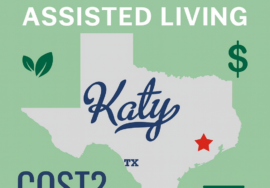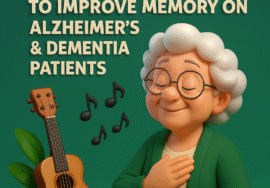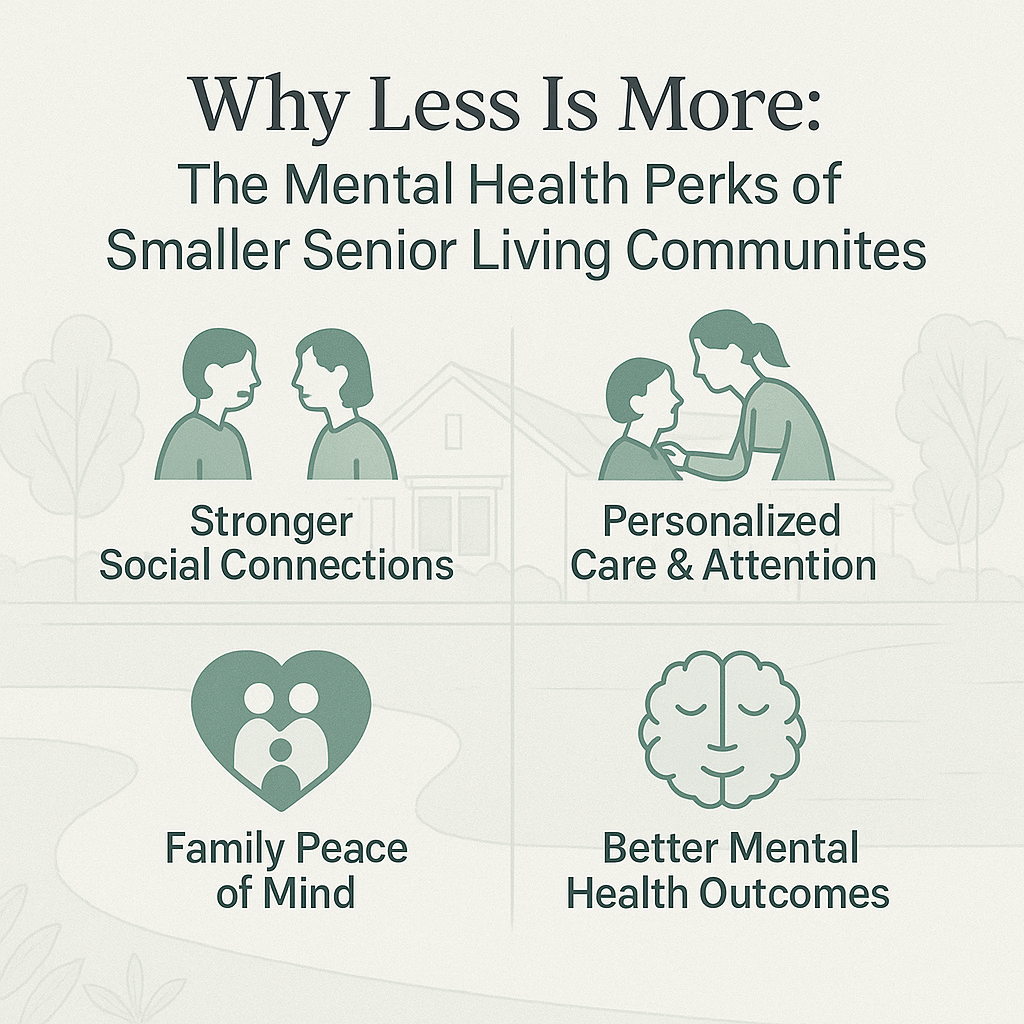
Living Independently at Home vs. in a Community
Introduction & Core Comparison
📌 Table of Contents
- Introduction: Why This Decision Matters
- Defining the Options: Aging in Place vs. Community Living
- Financial Considerations
- Health & Safety Comparison
- Social Connection & Mental Wellness
- Lifestyle & Convenience Factors
- Conclusion & What to Expect Next
1.Why This Decision Matters
Choosing between staying at home or moving into a senior community is one of the most important decisions for older adults and their families. It’s a pivotal moment that affects quality of life, health, finances, and emotional well-being. As 8 in 10 seniors prefer aging in place (AssistedLiving.org, Hartford Funds) yet often underestimate costs (MarketWatch), understanding the core differences is essential.
2. Defining the Options
🏠 Aging in Place
- Living in your personal residence with possible medical in-home support like aides or homemakers.
- Costs can reach $75,500 annually for full-time home health care (MarketWatch).
- Includes home modifications (grab bars, ramps) to ensure safety (Wikipedia).
🏡 Community Living (Assisted & Independent)
- Independent living: Maintenance-free, social lifestyle—average ~$2,750/month (Wikipedia).
- Assisted living: Adds help with daily tasks—costing $4,500/month ($54,000/year) (Choice Mutual).
- Katy, TX specific: Assisted living averages $5,350–$5,900/month (Pegasus Senior Living).
3. Financial Considerations
- Cost comparison:
- Full-time home care: ~$75,000+ annually
- Assisted living: ~$54,000–70,800 annually depending on location (Choice Mutual)
- Independent living is the most affordable community option (Wikipedia).
- Full-time home care: ~$75,000+ annually
- Hidden expenses: Home-based care may require home upgrades, transportation, and insurance increases.
- Payment sources: Medicare often doesn’t cover custodial care (Investopedia, MarketWatch); Medicaid and VA benefits may help—planning is vital.
4. Health & Safety Comparison
- In-home risks: Falls are a leading hazard—1 in 4 seniors per year (MarketWatch, cardinalbay.org).
- Tracking needs: Independent-living residents may deteriorate faster without daily observation.
- Community supervision: Assisted living provides care for ADLs—bathing, dressing, meds—77%, 69% need help with walking and bathing (CarePatrol).
- Homecare consistency: While offering one-on-one treatment, it can lack structure, especially overnight .
5. Social Connection & Mental Wellness
- Isolation at home: Residents aging alone may face loneliness—with 25.9% experiencing moderate loneliness (Wikipedia).
- Community benefits: Group activities, friendships, clubs—all available in communities .
- Quality-of-life gain: Top communities extend life expectancy and care days—70 extra days in top-tier senior housing (National Investment Center).
6. Lifestyle & Convenience Factors
- In-home perks: Comfort, routines, pets—it’s home (Friendly Faces Senior Care).
- Community ease: No chores, scheduled meals, housekeeping—less stress, more freedom .
- Flexibility vs structure: Home offers choice but may lack setup for emergencies; community offers structure and peace of mind around the clock.
Deep Dive: Health, Cognitive Changes, Local Options & Home Modifications
📌 Table of Contents
- Assessing Physical Health & Mobility
- Understanding Cognitive Changes & Memory Support
- Home Modifications for Aging in Place
- Key Criteria for Choosing a Community
- Comparing Katy, TX Community Options
- Personal Stories & Testimonials
- Conclusion & Next in Series
1. Assessing Physical Health & Mobility
- Importance for Safety: Declining mobility increases fall risk at home—leading cause of senior injuries.
- Home Care Requirements: Needing assistance with daily living (bathing, dressing, meals) can be managed in-home, but becomes costly and unreliable without consistent caregivers.
- Community Support: Assisted living offers trained staff, 24/7 supervision, and routine check-ins—ideal for those with limited mobility.
2. Understanding Cognitive Changes & Memory Support
- Early Signs Matter: Forgetfulness and confusion can impact medication management, finances, and safety.
- Home vs. Community: Memory-care communities offer structured routines, cognitive wellness programs, and secure environments.
- At-Home Adaptations: Repetition reminders, locked cabinets, and in-home aides may help—but aren’t a long-term solution for dementia.
3. Home Modifications for Aging in Place
- Accessibility Upgrades:
- Grab bars in bathrooms
- Ramps replacing steps
- Stairlifts or home elevators
- Non-slip flooring and enhanced lighting
- Grab bars in bathrooms
- Cost vs. Impact: While one-time upgrades (~$5,000–$15,000) may help, ongoing care and tech monitoring costs can outweigh community living costs over time.
4. Key Criteria for Choosing a Community
- Location & Commute: Proximity to family and medical appointments—Katy’s local clinics, MD Anderson satellite, Methodist West Hospital.
- Care Level & Licensing: Assisted living vs. independent vs. memory care—ensure Texas licensure.
- Amenities & Social Life: Dining options, scheduled activities, fitness classes, transportation services.
- Pricing Transparency: All-inclusive vs. à la carte—diet, therapy, medication administration, laundry.
- Reputation & Accreditation: Read reviews, visit communities, and check records via Texas Health and Human Services Commission.
5. Comparing Katy, TX Community Options
| Community | Level of Care | Monthly Cost (est.) | Standout Features |
| Facility A | Assisted | $5,500 | On-site therapy, memory care wing |
| Facility B | Independent/Assisted | $3,000–4,500 | Clubhouse, chef meals, pet-friendly |
| Facility C | Memory Care | $6,000+ | Secure wings, tailored cognitive programs |
| Facility D | Independent | $2,800 | Transportation to Katy Market, fitness classes |
6. Personal Stories & Testimonials
- Ms. Johnson’s Transition: From daily-living in her home to assisted living led to improved health and new friendships.
- Mr. Patel’s Choice: Selected independent living for community socialization with minimal care support.
- Family Reflections: Adult children share peace-of-mind deciding to transition—less stress, fewer safety worries.
Include quotes such as:
“Moving Dad into assisted living was the best choice—we saw a dramatic improvement in his appetite and social life.”
Deep Dive: Daily Life, Routines, Socialization & Support
📌 Table of Contents
- Meal Planning & Dining Experience
- Housekeeping & Home Maintenance
- Social Activities & Community Engagement
- Transportation & Access to Services
- Technology & Smart Support Systems
- Mental Wellness & Purposeful Living
- Conclusion & What’s Next
1. Meal Planning & Dining Experience
- Aging in Place: Cooking at home means full control over diet and schedule—yet shopping, meal prep, and cleanup present challenges. Grocery delivery helps, but fresh and nutritious meal planning can become difficult as mobility decreases.
- Community Living: Nutrition-rich, professionally prepared meals served in dining venues. Options accommodate dietary needs (low sodium, diabetic-friendly), and residents enjoy social dining with peers.
SEO Tip: Use keywords like “senior meal delivery Katy TX”, “assisted living dining options.”
2. Housekeeping & Home Maintenance
- Home-Based Living: Requires chores like cleaning, yard work, repairs—either done by the senior, a caregiver, or costly contractors.
- Community-Based: Maintenance, landscaping, housekeeping, laundry, and even linen services are included. More resources become available without additional effort.
SEO Tip: Target “senior home upkeep help Katy” and “assisted living housekeeping services.”
3. Social Activities & Community Engagement
- Living Alone: While independent living at home offers familiar routines, social isolation is a real risk. Scheduling outings or joining local groups requires effort and transportation.
- In a Community: Regular group events like fitness classes, game nights, arts & crafts, spiritual gatherings, and day trips to Katy destinations like LaCenterra or Porter’s.
SEO Tip: Use “senior activities Katy TX”, “assisted living social programs.”
4. Transportation & Access to Services
- At Home: Seniors must arrange rides to appointments, shopping, and social visits—using family, ride-share services, or public transit, which may not be ideal for all.
- Within a Community: Scheduled transportation services for appointments, errands, outings, with comfortable, accessible vehicles.
SEO Tip: Include “senior transportation Katy TX”, “assisted living shuttle services.”
5. Technology & Smart Support Systems
- Home Setting: Seniors living at home often rely on smartphones for reminders, GPS phones, or telehealth platforms. Each device needs setup and training.
- Community Integration: Many facilities include tech-powered tools—personal emergency pendants, building-wide alert systems, smart thermostats, video call stations, and sometimes onsite telemedicine.
6. Mental Wellness & Purposeful Living
- Living Alone: Mental stimulation depends on individual habits—hobbies, volunteering, or community classes, but opportunities may feel limited.
- Assisted/Independent Communities: Curated programs promote fitness, art, music therapy, intergenerational events, and cultural celebrations.
SEO Tip: Keywords: “senior mental health programs Katy”, “purpose-driven senior living.”
Wrap-Up: Decision-Making FAQ + Transition Guidance
📌 Table of Contents
- Recap: Comparing Home vs. Community Living
- Step‑by‑Step Transition Guide
- Top 20 FAQs for Seniors & Families
- Conclusion: Making Peace with the Move
1. Recap: Comparing Home vs. Community Living
In Volumes 1–3, we’ve examined:
- Costs & finances: Home care vs. community pricing in Katy TX
- Health & safety: Fall risk, cognitive support, ADLs
- Daily life: Meal, housekeeping, transportation, tech systems
- Social & mental wellness: Engagement, purpose, mental health
Understanding these differences helps families determine the best setting for loved ones’ well‑being and quality of life.
2. Step‑by‑Step Transition Guide
- Assess Needs
Use tools like fall‑risk checklists, cognitive screenings, and mobility tests to gauge the care level needed. - Explore Options
Tour 2–3 local Katy communities and compare against home‑care cost estimates including modifications and aide services. - Review Financial Plans
Include budgets for downsizing, VA benefits, Medicaid, or long‑term care insurance. - Plan the Move
Host a family meeting, involve the senior in decision‑making, and schedule move‑in details (packing, address updates, care wrap‑up). - Settling In
Facilitate introductions to neighbors, join activity clubs, and schedule follow‑up health checks. - Ongoing Adjustment
Stay involved with regular family visits, care plan updates, and monitor senior satisfaction and health.
3. Top 20 FAQs for Seniors & Families
1️⃣ What is the typical cost difference?
Home caregiving ranges from $60K–$80K/year (full in-home care), while assisted living in Katy TX averages $5K–$6K/month (≈$60K–$72K annually).
2️⃣ Does Medicare cover assisted living?
No—Medicare covers skilled medical services, not custodial care. Medicaid waivers or VA benefits may help; plan ahead.
3️⃣ How do I know when independent living turns into assisted care?
Look for changes in ADLs—difficulty bathing, dressing, managing meds, or cooking may signal need for assisted-level support.
4️⃣ Can I get home modifications before moving out?
Yes. However, budget for both these upgrades and monthly assisted living fees to compare costs accurately.
5️⃣ How do community meal programs work?
Scheduled dining options vary—family-style meals, dietary accommodations, snacks, and alternatives are typically available daily.
6️⃣ Will my pet be allowed in community living?
Many independent living communities are pet-friendly. Assisted living often has restrictions; inquire during visits.
7️⃣ How is medical care managed on-site?
Assisted-living communities coordinate medication, partner with visiting nurses, and have emergency response systems.
8️⃣ Can residents bring their own furniture?
Yes—residents furnish their apartments. Many families bring photos and personal items to ease the transition.
9️⃣ Is transportation provided?
Yes—scheduled shuttles for appointments, shopping, and visits to local Katy attractions and hospitals.
🔟 Can families stay involved?
Absolutely—most communities encourage family participation in care planning, visitation, and event attendance.
1️⃣1️⃣ What about overnight care or emergencies?
Staffed 24/7 in assisted living. Homes may need emergency response pendants and caregiver schedules covering nights.
1️⃣2️⃣ How long does it take to adjust?
Varies—average transition takes 3–6 weeks to build routines, friendships, and comfort.
1️⃣3️⃣ Are visitors and outside programs allowed?
Yes—most communities welcome guests, therapies, local groups, spiritual meetings, and volunteer visits.
1️⃣4️⃣ What if my loved one misses home?
Personalize apartment with familiar items, maintain home visits, and encourage meaningful activities to ease nostalgia.
1️⃣5️⃣ How are memory-care needs handled?
Secured wings, daily routines, cognitive therapies, and staff training are included in memory-care/assisted living options.
1️⃣6️⃣ Are there penalties for early contract termination?
Contracts vary—ask about deposit refunds, notice period, and exit fees during community review.
1️⃣7️⃣ What’s the admissions process like?
Typically includes a health assessment, personal preferences review, contract signing, financial planning, and move-in logistics coordination.
1️⃣8️⃣ Can I take short respite stays?
Many communities offer respite or trial stays—contact them to learn more.
1️⃣9️⃣ How can I involve siblings or cousins in care?
Set up shared care plans, invite family to assessments, and host regular update meetings.
2️⃣0️⃣ What if needs change over time?
Continuum-care communities allow shifting between levels (independent → assisted → memory care) without relocating.
4. Conclusion: Making Peace with the Move
Deciding between staying at home or moving into community living is a profound choice shaped by health, finances, safety, and social wellness. There’s no one-size-fits-all answer—but thoughtful assessment, proactive planning, and honest family conversations help make a transition smoother and more fulfilling.
Katy, TX offers many quality options—from independent living to specialized memory care—with structures in place to support seniors’ evolving needs.








